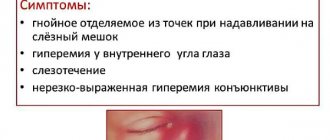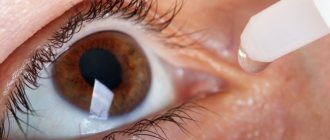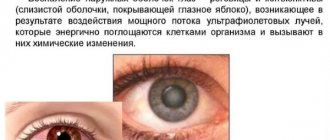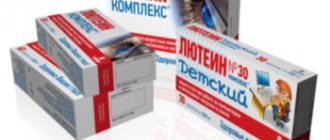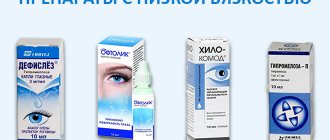Composition and release form
Ophthalmoferon is a combined antiviral agent in the form of eye drops. The medicinal solution is colorless, absolutely transparent, has no foreign inclusions, and does not precipitate.
1 ml of the drug contains 10,000 IU of human interferon, a protein that is produced by the immune system and makes cells immune to viral infection. The composition also includes 1 mg of diphenhydramine, an antihistamine (anti-allergic) compound.
Auxiliary components:
- boric acid ─ the basis for multicomponent preparations;
- povidone, macrogol ─ binder;
- sodium chloride ─ solvent;
- disodium edetate ─ enhances the adsorption (absorption) of a solution through the mucous membranes;
- sodium acetate ─ acidity regulator;
- hypromellose ─ stabilizer, emulsifier;
- purified water.
The drug is available in 10 ml plastic dropper bottles or in glass bottles (10 ml), tightly closed with rubber stoppers and rolled up with an aluminum protective cap. The glass bottle in a cardboard box comes with an additional plastic dropper attachment.
Composition and packaging
The composition of Oftalmoferon eye drops includes the following active substances:
- interferon alpha-2b human recombinant;
- diphenhydramine (an antihistamine).
There are no analogues of Ophthalmoferon for the active substance, but eye drops with a similar pharmacological effect are produced:
- Poludan (promote the synthesis of interferon);
- Aktipol;
- Oftan-I'm coming.
The drug is in a bottle with a drip dispenser, equipped with a ring to control the first opening. The hole in the lid is narrow, allowing the drops to be used in a strictly specified dosage without coming into contact with the mucous membrane of the eye.
The product is a colorless, transparent solution of uniform, odorless consistency. When instilled, the drops do not cause redness or lacrimation, but can cause discomfort in the form of burning and tingling.
The price of Oftalmoferon is from 293 rubles per 10 ml bottle. The medicine should be stored in the refrigerator; after opening, the drops must be used within a month.
Operating principle
Interferon prevents the replication (multiplication) of viruses. The substance does not have a direct antiviral effect, but it causes chemical changes in cells after which they become immune to the pathogen.
When interferon gets on the mucous membrane of the eye, it affects the body in the following way:
- the protein, penetrating healthy cells, triggers the production of substances that resist viral attack;
- uninfected cells actively synthesize components that destroy the RNA of viruses and lead to their death;
- the drug activates powerful immune defense at the cellular level;
- human interferon activates the TP53 gene, which programs the process of apoptosis ─ death of an infected cell.
Interferon is the most powerful stimulator of the children's immune system. Enhances the activity of lymphocytes, leukocytes, massively produces neutrophils (microbe killer cells) and macrophages (cleanse the body of dead parasitic cells).
The diphenhydramine contained in the composition relieves itching, inflammation, swelling, and redness of the mucous membranes of the eyes. Causes short-term pain relief and has a calming effect on irritated conjunctiva.
Pharmacological action of Oftalmoferon:
- antivirus;
- anti-inflammatory;
- anesthetic;
- immunomodulatory;
- restorative.
Analogs
Oftalmoferon has a number of analogues. A medicine with the same active ingredient is human interferon, which is taken orally. As for similar cheap ophthalmic drops, Oftalmoferon is the only drop with interferon. Drugs used for the same diseases as Oftalmoferon:
- Tobrex – contains the antibiotic tobramycin, used to treat bacterial infections;
- Vitabact is an inorganic antiseptic;
- Sodium sulfacyl is an inorganic antiseptic;
- Albucid - drops with the same active ingredient as sodium sulfacyl;
- Okomistin is an antimicrobial agent;
- Hydrocortisone – anti-inflammatory hormonal drops;
- Visine – relieves eye fatigue;
- Derinat is a drug that enhances the recovery of the cornea after injury.
Indications
Eye drops are prescribed to children for viral conjunctivitis caused by herpes, adenovirus, and enterovirus.
The medicine is effective for the following types of keratitis (viral inflammation of the cornea):
- dotted ─ small dotted defects on the cornea scattered throughout the epithelium;
- vesicular ─ superficial form of eye herpes;
- dendritic ─ a herpetic infection that leaves small erosions on the cornea that form after the vesicles open;
- map-like ─ corneal defects in the form of cartographic patterns.
The drug is effective for stromal keratitis, when inflammation spreads to the deeper layers of the cornea and other eye structures, provided there are no ulcers.
Oftalmoferon is suitable for the treatment of keratoconjunctivitis, inflammation of the vascular network of the eye caused by the herpes simplex virus (uveitis), keratouveitis, including ulcerative ones.
Drops are prescribed for dry eye syndrome (chronic deficiency of tear fluid).
The drug is dripped after surgical treatment on the organs of vision. This allows you to avoid complications and the addition of a secondary (bacterial) infection.
Indications for use
According to the instructions for use, Oftalmoferon is prescribed for:
- xerophthalmia;
- eye damage due to chickenpox, allergic diseases;
- inflammation of the uveal tract of herpetic origin;
- conjunctivitis (non-bacterial etiology);
- herpetic or adenoviral keratitis (inflammation of the cornea) and keratoconjunctivitis (inflammatory lesion of the cornea and conjunctiva).
Oftalmoferon is recommended as a prophylaxis for keratitis and other complications after surgical interventions on the organ of vision (keratoplasty, laser correction of astigmatism).
Oftalmoferon: instructions for use
It is important to understand that a correct diagnosis can only be made by a specialist, so you should not self-medicate: before using Oftalmoferon eye drops, you should consult a doctor.
Instructions for use for children
Drops are used only conjunctivally.
- For acute eye infections by viruses, infants of the first year of life are instilled with 1 drop up to 6 times a day. From 1 to 7 years ─ 1-2 drops 6 to 8 times a day. Schoolchildren and adolescents are prescribed 2 drops in each eye every 2 hours. As the acute inflammation subsides, the daily dose is adjusted to 2-3 instillations. The duration of the therapeutic course is until the signs of the disease completely disappear.
- For low-grade chronic inflammation, the solution is used 2-3 times a day, 1-2 drops into the affected eye.
- If a child has dry eye syndrome, use the product daily for a month. Treatment regimen: 1 drop into the conjunctival sac every morning and evening.
- As a preventive measure after surgical treatment, Oftalmoferon is instilled 1-2 drops up to 3-4 times a day for 14 days.
Dosage and method of administration
The duration of treatment with Oftalmoferon is determined by the doctor depending on the diagnosis and condition of the patient. As a rule, therapy continues until symptoms in pathologies of the organ of vision are completely relieved.
Use drops conjunctivally (in the space between the eyeball and eyelid). The procedure is carried out:
- washing your hands thoroughly with soap;
- without touching the dispenser to the mucous membrane of the eye.
Before using Oftalmoferon drops, you should remove them from the refrigerator in advance to avoid discomfort from the cold solution.
Treatment regimen with Oftalmoferon:
- for viral pathologies - 1-2 drops 6-8 times a day (after reducing inflammation, the frequency of instillations is halved);
- for dry eye syndrome - 1-2 drops twice a day;
- after surgical procedures, drops should be used 1-2 drops 2-4 times a day starting from the day of the operation.
If the doctor has prescribed other drugs for topical use, they must be used 10-15 minutes after instillation of Oftalmoferon.
How to give eye drops to a child
Carrying out medical procedures on children is difficult, especially if they involve the eyes. It is important not to injure the baby, so try to calm or distract the child:
- If the baby is small, ask one of the adults to fix his head and hands - this will give you a few seconds to manipulate.
- If the child is older, allow him to take a horizontal position and close his eyes. With a clean hand, lift the upper eyelid and drop the medicine into the inner corner of the eye and allow it to blink for 10-20 seconds. This allows the baby not to squint or squirm due to possible unpleasant sensations, and for the drops to be evenly distributed throughout the mucous membrane.
Side effects and overdose
The medicine is well tolerated by children. No cases of overdose have been recorded in pediatric practice.
Ophthalmoferon, when used topically, is not absorbed through the conjunctiva into the bloodstream. Therefore, it does not affect the functionality of the child’s vital organs.
In rare cases, a slight burning sensation in the eyes was noted. Children with a history of severe allergies may develop local hypersensitivity reactions:
- itching, irritation;
- hyperemia of the mucous membrane;
- swelling of the eyelids;
- peeling of the skin around the eyes;
- urticaria, allergic dermatitis.
Interferon is dangerous when the drug is injected into the blood. In this case, children develop disorders of the nervous system ─ partial or complete paralysis of skeletal muscles and oculomotor nerves. Failures of heart contractions and arrhythmias occur. Schoolchildren experience mental disorders such as depressed mood, chronic depression, and suicidal tendencies.
When using eye drops according to the instructions, it is impossible for Oftalmoferon to enter the bloodstream. Therefore, the medicine is safe for children of all ages.
In what cases is it necessary to take medicine?
This drug is prescribed mainly for patients with conjunctivitis. It can reduce discomfort in the eye and relieve burning sensation.
It is also effective for the following ailments:
- inflammatory eye diseases: keratitis, iridocyclitis and other pathologies of a viral or microbial nature;
- hay fever or spring conjunctivitis caused by flowering plants, pollen, etc.;
- on the eve or after surgery, in order to prevent infectious complications;
- in the treatment of corneal ulcers;
- in the treatment of dry eye syndrome;
- in the treatment of herpetic keratouveitis and uveitis.
When and how to use the drug for a runny nose?
The viral nature of rhinitis is suppressed with Oftalmoferon. The components of the solution will not only moisturize the nasal mucosa, but also protect the cavities from the penetration of bacteria. It is worth using eye drops when the color of nasal discharge changes.
The combined agent has a detrimental effect on viruses that cause inflammation and swelling of the nasal mucosa. A special feature of the drug is its ability to moisturize the nasal epithelium. It also has an antiallergic effect, which is important for rhinitis caused by a reaction to pollen.
Use the drug three times a day, instilling two drops into each nostril.
If you start instilling Oftalmoferon, it is important to maintain the humidity level in the room. The air temperature in the house is maintained at 20–23 degrees Celsius.
The drug is contraindicated in case of individual intolerance to the components of the drug.
Women use drops with caution during pregnancy and lactation.
Description of the drug
The main substance of Oftalmoferon eye drops is a recombinant interferon of a protein nature, active against viruses. A type of interferon alpha 2b is used to treat serious viral diseases. The substance, entering the patient’s body, prevents the proliferation of viruses at the cellular level. Thanks to interferon, cells activate the synthesis of enzymes that suppress the spread of infection. The interferon treatment system plays an important role in protecting against viruses.
Oftalmoferon drops also contain thousandths of grams:
- diphenhydramine with local anesthetic effect;
- boric acid as a protectant against bacteria;
- Trilon stabilizer;
- polyvinylpyrrolidone - a thickener for medicinal solutions;
- hypromellose for the formation of complex compounds, moisturizing the mucous membrane.
Oftalmoferon eye drops are prepared in an isotonic sodium chloride solution. In addition, this substance relieves swelling of the mucous membrane.
The drug is intended for instillation into the eyes. It is a topical remedy, eliminating the symptoms of inflammation.
